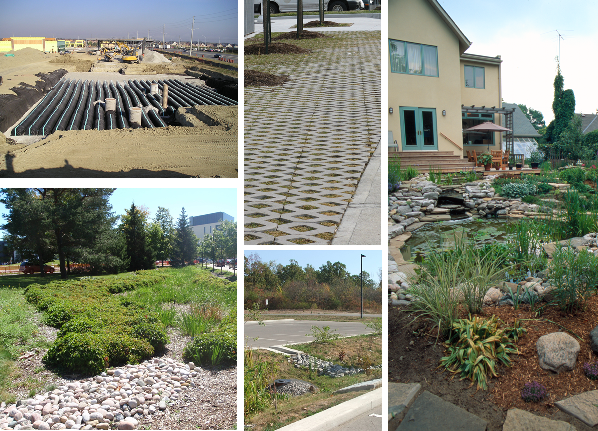Review of the Science and Practice of Stormwater Infiltration in Cold Climates
 Stormwater infiltration practices that direct runoff to pervious areas or engineered structures for storage and eventual infiltration are central to Low Impact Development because the infiltration component of the water balance is substantially reduced under most urban development scenarios. These practices can provide multiple benefits where conditions are suitable. They reduce runoff volume and thereby minimize flood risk and prevent alterations to the natural channel and stream flow regime. They help to maintain groundwater levels and sustain stream flows during dry periods. They also reduce pollutant loading to receiving watercourses from runoff by retaining contaminants in the engineered structures and underlying soil.
Stormwater infiltration practices that direct runoff to pervious areas or engineered structures for storage and eventual infiltration are central to Low Impact Development because the infiltration component of the water balance is substantially reduced under most urban development scenarios. These practices can provide multiple benefits where conditions are suitable. They reduce runoff volume and thereby minimize flood risk and prevent alterations to the natural channel and stream flow regime. They help to maintain groundwater levels and sustain stream flows during dry periods. They also reduce pollutant loading to receiving watercourses from runoff by retaining contaminants in the engineered structures and underlying soil.
This review provides an updated summary of the body of knowledge on infiltration based stormwater management. Particular emphasis is placed on peer reviewed journal articles and published reports from jurisdictions with climate and soil conditions similar to Ontario, including the northeastern United States, United Kingdom, France, Norway, Sweden, Denmark, Germany, Austria, Switzerland and Japan. The review includes the following components:
- Comparison of guidelines regarding the suitability and siting of stormwater infiltration practices from selected cold climate jurisdictions
- Description of general types of infiltration practices, their typical application, and pretreatment requirements
- Summary of stormwater management issues specific to cold climates
- Overview of typical urban runoff contaminants and the physical, chemical and biological processes by which these may be treated as water percolates through soil
- Review of literature addressing the risk of soil and groundwater pollution from application of stormwater infiltration practices and associated management recommendations
- Summary of available information on the performance of each type of infiltration practice with regard to runoff reduction, surface water quality, groundwater quality, and soil quality
- Outline of typical inspection and maintenance requirements for each type of infiltration practice
